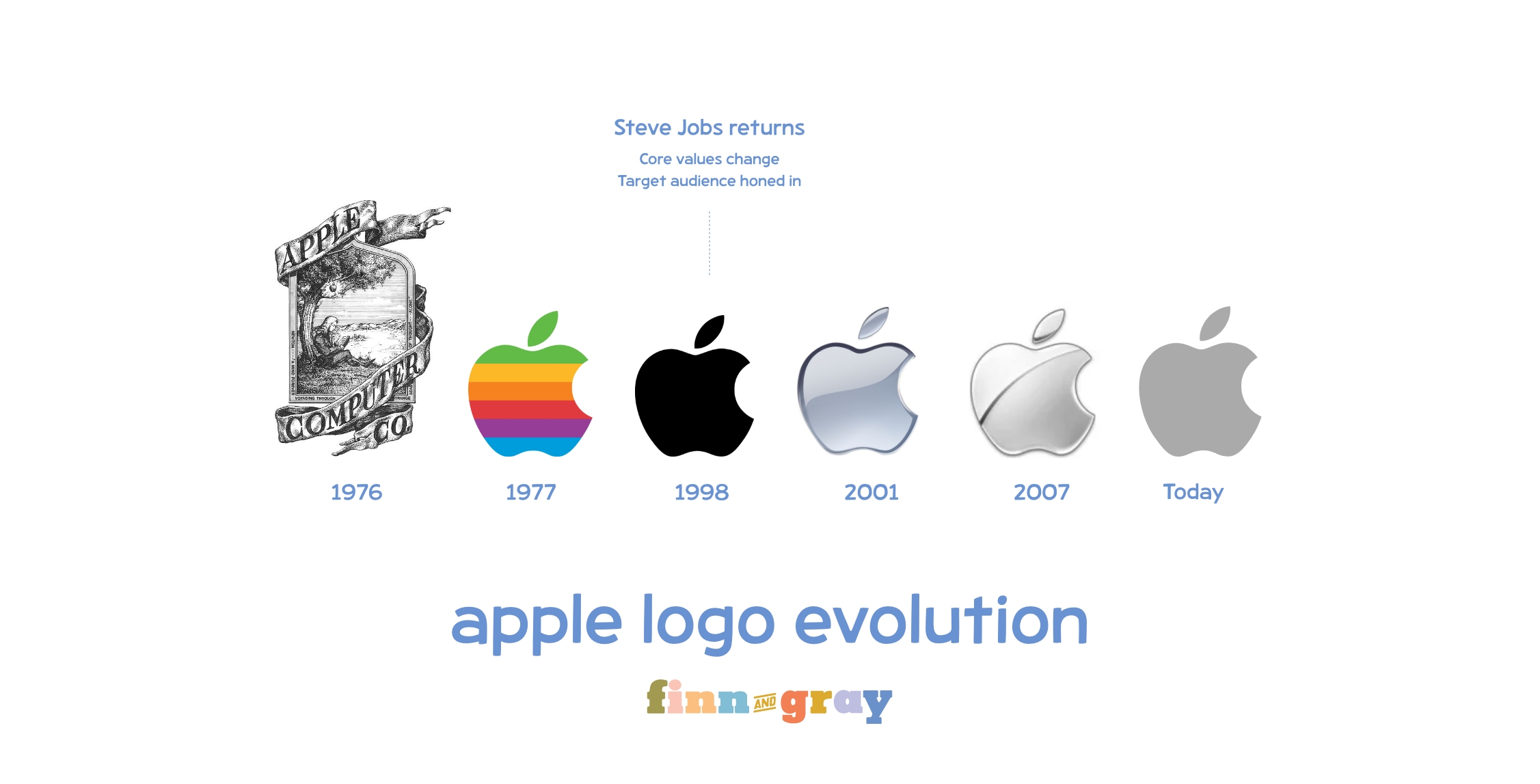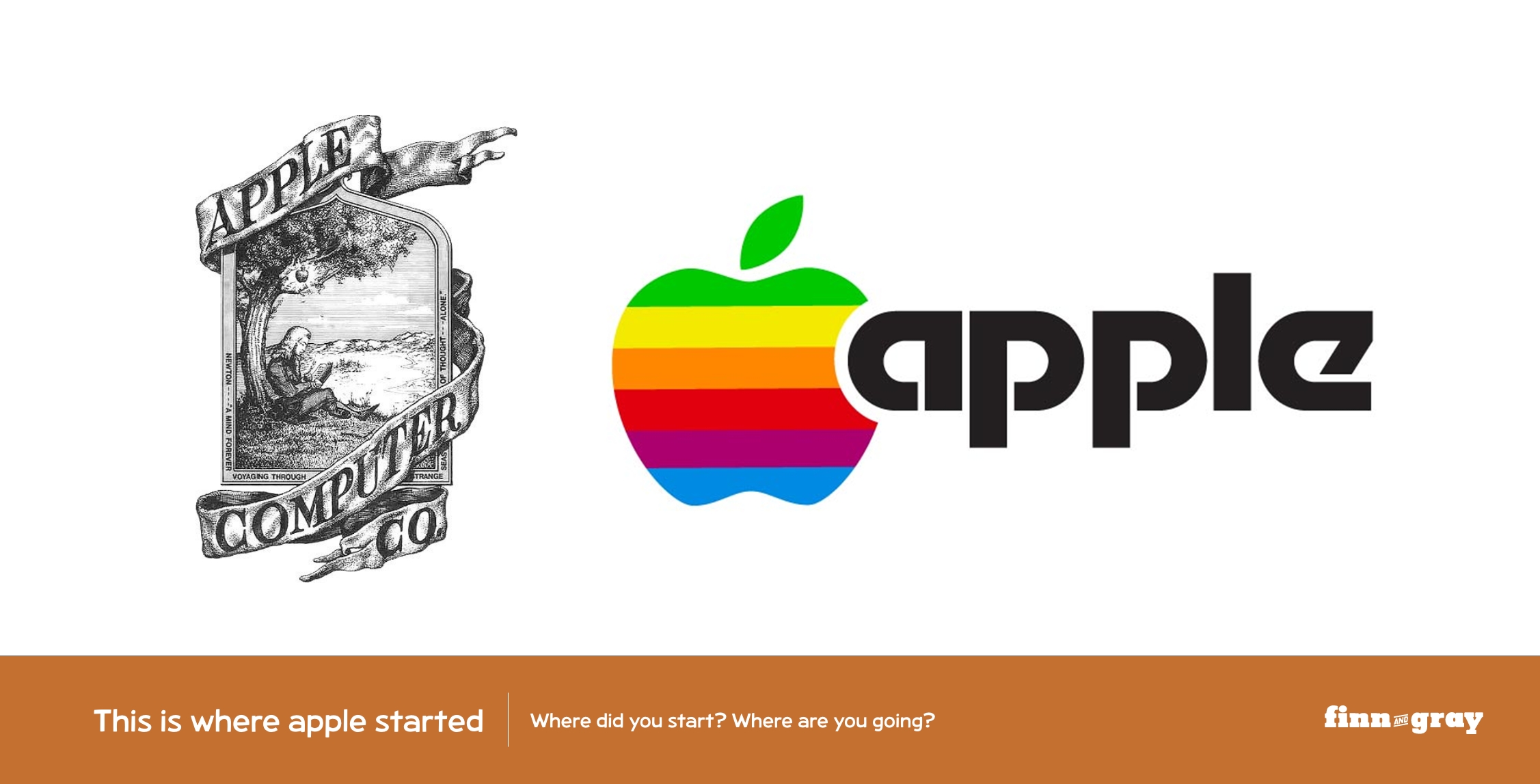Rebranding your business is never something to enter into lightly but it definitely should be considered. With market changes, business core value evolution and growth, you’ll need to think about rebranding more than you initially thought.
There once was a business that had it’s messaging all backwards, wasn’t doing as well as they had out of the gate, and needed to look both inward and outward to discover why they weren’t doing as well. Their CEO left and the leadership team brought back a former employee to run the company and things started to change for the better immediately. They were determined to understand their customer’s needs more than any of their competition. Their values shifted. Their message shifted. It was time for a rebrand. Does anyone know who this company was?
annnnyone?
Apple!
In fact, they have rebranded many times in their history.

What The Heck is a Rebrand?
A rebrand can be defined in many ways. In some cases, it’s simply updating your marketing campaign efforts through messaging and visuals.
In other cases, it’s throwing everything the window and starting fresh. In most cases, it’s evolving your brand to better match your business as it stands today. In any case, knowing when to do a rebrand can often give business owners and marketing teams anxiety.
We’ve been there, working as the in-house creative team at the largest global fitness franchise before starting Finn & Gray. Updating the logo was constantly discussed, but it was often met with “not right now”.
When Should You Rebrand?
There are signs that it’s time to rebrand. Here are some questions to ask yourself, prompts to look at your competition, and questions to ask your audience/current customers.
- Do you feel like your logo/brand/visuals still represents what you offer?
- Does it represent your unique advantage?
- Do you think your logo resonates with your audience? (Really think on this one)
- Is there more competition in your industry than when you started?
- How does the competition look? What are their attributes?
- Did you pull something together quickly just so you could get rolling with your brand but it’s really not right for you anymore? Maybe it never was…
- Did you “design” your logo, website, or other visuals yourself?
- Do you look trustworthy? Again, ask your audience about this one.
- Did you purchase a business and the brand/logo doesn’t resonate?
- Have you added services or changed products since you started?
74% of the S&P 100 companies have rebranded their business in the first seven years. (crowdspring)
The Business Owner’s Dilemma: Why Rebrand
1. You’ve expanded your product or service offerings and your visuals no longer accurately represent your business
If your business has expanded into new products, services or markets, your brand/logo/visuals may no longer accurately represent your business. Rebranding can align your brand with your business goals and offerings. Through proper messaging, a more suitable logo mark, and visuals that bolster trust, you are sure to make a good first impression and be memorable.
2. Your brand is outdated and no longer resonates with your target audience
60% of consumers avoid companies with logos that have weird or unappealing designs, even if they have good reviews. If your brand feels dated, uninteresting, or out of touch with your target audience, it may be time for a change. Rebranding can help update your image and improve engagement with your audience.
When we helped evolve Delaget’s brand, we simply refreshed the logo and spent most of our time on their brand style. We gave them a whole new vibe through a new visual style guide (typography, color palette, etc.) website upgrades and style for social media.
3. You’re falling behind your competition
If your competitors have a strong brand and you’re being left behind, it may be time to consider a rebrand to remain competitive and relevant. And a rebrand in this case wouldn’t have to be throwing the baby out with the bathwater. You could simply update your messaging and visuals to stand out once more.
Three Steps to Take Before Rebranding
A. Conduct market research to understand your target audience’s perception of your brand
Set up calls with your audience. Create a customer panel where you can ask questions about the experience of your brand and the elements and visuals that make up what you present to the world. Ideally, you will walk away with tangible feelings about your business and it’s perception from customers.
B. Evaluate your business goals and whether your current brand supports them
Does your current branding support your business goals? What do you want to accomplish not only in 2023 but also in 2028? How will you get there? Do your brand elements support that or hinder its accomplishment?
C. Assess the cost and resources required for a successful rebrand
On average, companies spend 5-10% of their annual marketing budget on rebranding. Thinking it’s time to give your brand a facelift? Make sure to budget for the rebranding effort — not just hiring but the printing costs and reproduction of signage.
At Finn & Gray, we’ve worked with many brands that can update everything at once. We have also worked with companies that require a slower rollout plan that ensures they don’t have to make all the investments in new items all at once. There aren’t clear-cut rules for how a rebranding must roll out.
Developing Your Rebranding Strategy
If you are sitting on the other side of your computer thinking this might be the time to either refresh or rebrand your business, we are here for you.
- Work with Finn & Gray to facilitate your rebranding strategy and planning. Fee goes towards your project, when F&G builds out the new brand.
- Gather your team and bring them into the rebranding journey, sharing your goal.
- Together, we’ll develop a clear brand vision and identity (core values are imperative too).
- Determine the scope of the rebrand (partial or full)
Finn & Gray’s Process to Execute a Rebrand
Step 1: Together, we will determine your rebranding goals. Knowing what you want out of the new brand is an imperative.
- Goal Example: To better reflect our values and mission through rebranding.
- KPI (Key Performance Indicator): Increase in customer engagement with brand messaging that emphasizes sustainability and ethical practices, as measured by social media shares, likes, and comments.
- KPI: Increase in sales of products or services that align with our core values, as measured by revenue generated from these offerings.
- Goal Example: To reach a new target audience through rebranding.
- KPI: Increase in website traffic and click-through rates from the targeted demographic, as measured by Google Analytics.
- KPI: Increase in new customer acquisition from the targeted demographic, as measured by the number of new customer sign-ups or purchases.
Step 2: Design and Develop a new brand identity, this usually includes elements such as a new logo, color scheme, and visual elements.
Step 3: Update your website and marketing materials.
Step 4: Launch your new brand with a clear message and targeted marketing campaign.
Determining if a rebrand is in your future should be evaluated by looking at your customers, competition and the company itself. Investing in this process for your business will help if you are seeking to refresh your look, garner new customers, and/or to grow your business. A successful rebrand requires a clear vision, commitment to the process (and your business growth), and a willingness to adapt and evolve.

